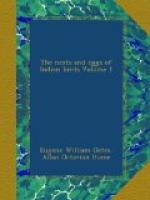“Evidently this nest was not originally made by the Shrike, but, as would appear, was taken possession of by it, after the brood of some other species of birds had left it.”
Mr. W. Theobald makes the following note of this bird’s breeding in the neighbourhood of Pind Dadan Khan and Katas in the Salt Range:—“Lays in the last week of March to the end of April. Eggs five only, shape ovato-pyriform, size 1.06 inch by 0.8 inch; colour pale greenish white, blotched and tinged with yellowish grey and neutral markings; vary much in intensity and colour. Nest of twigs, lined with cotton or wool, and usually placed in stiff thorny bushes.”
Lieut. H.E. Barnes, writing from Chaman in Southern Afghanistan, remarks:—“The Grey-backed Shrike is extremely common, breeding about the end of March, in much the same situations as in India. I have collected many specimens, and failed to detect any difference between the Indian bird and the one found here. The average of twelve eggs is .97 by .75.”
He adds subsequently:—“This is the commonest Shrike in the country; it breeds in March and April, and the young are easily reared in captivity.”
Mr. W. Blewitt says that he “took four nests of this bird near Hansee on the 28th-30th March; they contained, one 5, two 4, and one 3 eggs; all but the latter (which, curiously enough, were a good deal incubated) quite fresh. The nests were placed in acacia and caper bushes, at heights of from 6 to 14 feet from the ground; they were from 6 to 7 inches in diameter exteriorly, rather loosely constructed of thorny twigs, with egg-cavities from 2 to 21/2 inches deep, lined with fine straw and leaves.” Again he writes: “Took numerous nests in the neighbourhood of Hansee during the month of July; most of the eggs were much incubated, and four was the largest number found in any one nest.
“The nests were all placed upon keekur trees at an average height of some 10 feet from the ground; they were composed of thorny twigs, some with and some without a lining of fine grass and feathers, and averaged some 5 or 6 inches in diameter by 2 to 4 inches in depth.”
Major C.T. Bingham says that “this bird is excessively common about Delhi, far more so than at Allahabad. At the latter place I only found it breeding in March and April, but at Delhi I have found nests in every month from March to August. One evening in June I remember counting in my walk thirteen nests within the radius of a mile; some of these contained fresh eggs, some hard-set, some young. One nest I robbed in April of eggs contained young in the latter end of May, and I believe many of them have two if not more broods in the year. All nests that I have seen have been well made, firm, deep cups of babool branches, lined with grass-roots, and occasionally with bits of rag and tow. The eggs are broad ovals of a dead chalky bluish-white colour, spotted, chiefly at the large end, with purple and brown. Five is the greatest number of eggs I have found in a nest.”




